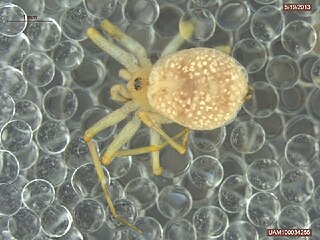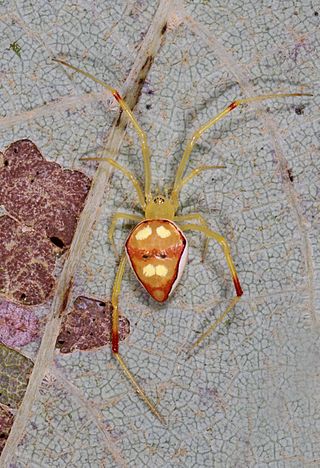
The Mygalomorphae, or mygalomorphs, are an infraorder of spiders, and comprise one of three major groups of living spiders with over 3,000 species, found on all continents except Antarctica. Many members are known as trapdoor spiders due to their creation of trapdoors over their burrows. Other prominent groups include Australian funnel web spiders and tarantulas, with the latter accounting for around one third of all mygalomorphs.

The Pholcidae are a family of araneomorph spiders. The family contains more than 1,800 individual species of pholcids, including those commonly known as cellar spider, daddy long-legs spider, carpenter spider, daddy long-legger, vibrating spider, gyrating spider, long daddy, and skull spider. The family, first described by Carl Ludwig Koch in 1850, is divided into 94 genera.

Lampshade spiders, family Hypochilidae, are among the most primitive of araneomorph spiders. There are two genera and twelve species currently recognized. Like mygalomorphs, most hypochilids have two pairs of book lungs, but like araneomorphs they have intersecting fangs, with the exception of some species which have chelicerae in an angle that is neither orthognathous or labidognathous. These long-legged spiders build typical "lampshade" style webs under overhangs and in caves. In the United States the fauna is primarily associated with the Appalachian, Rocky and California Mountains. Ten of the known species are found in these ranges, all in the genus Hypochilus. The genus Ectatosticta is found in China.

Sphodros is a genus of North American purseweb spiders first described by Charles Athanase Walckenaer in 1835. It was considered a synonym of Atypus until 1980.

Antrodiaetus is a genus of American and Japanese folding trapdoor spiders first described by Anton Ausserer in 1871. The name is a combination of the Greek "antrodiaitos" (αντροδιαιτος), meaning "living in caves", "antron" (αντρον), meaning "cave", and "diaita (διαιτα), meaning "way of life, dwelling".

Hypochilus thorelli is a species of spider in the family Hypochilidae. Unlike almost all other araneomorph or "true" spiders, members of the family have four book lungs. They are often called "lampshade spiders" because of the shape of their webs which are usually built underneath ledges or projections. H. thorelli is found in the southern Appalachian Mountains of the eastern United States.

Hypochilus is a genus of North American lampshade spiders that was first described by George Marx in 1888.
Anthrobia is a genus of North American dwarf spiders that was first described by T. Tellkampf in 1844.
Castianeira occidens is a species of true spider in the family Corinnidae. It is found in the United States and Mexico.

Oecobius cellariorum is a species of wall spider in the family Oecobiidae. It is found in a range from Southern Europe to North Africa, Jordan and Iran, has been introduced into the United States, China, and Japan.

Pimoa altioculata is a species of true spider in the family Pimoidae. It is found in the United States and Canada.
Pholcophora americana is a species of cellar spider in the family Pholcidae. It is found in the United States and Canada.

Castianeira gertschi, the Gertsch antmimic, is a species of true spider in the family Corinnidae. It is found in the United States and Canada.

Spintharus flavidus is a species of cobweb spider in the family Theridiidae. It is found in a range from the United States to Bolivia and Brazil.

Steatoda albomaculata is a species of cobweb spider in the family Theridiidae. It is found in North America, Europe and Russia, North Africa, Israel, Kazakhstan, Iran, Central Asia, China, Korea, Japan.

Hypochilus pococki, or Pocock's lampshade-web spider, is a species of lampshade weaver in the family Hypochilidae. It is found in the United States.
Hypochilus bonneti is a species of lampshade weaver in the spider family Hypochilidae. It is found in the United States.
Frederickus coylei is a species of dwarf spider in the family Linyphiidae. It is found in the United States and Canada.












